Established in 1873 Canterbury College, as it was then known, was only the second university in Aotearoa New Zealand.
It was set up on the Oxbridge model with one major difference: women students were admitted from the start. An early graduate, Helen Connon, became the first woman in the then British Empire to win honours.
Housed in graceful stone buildings on a central city block, the College was dependent on rents from high country farms with which it had been endowed by the Canterbury Provincial Council.
Ernest Rutherford, Canterbury’s most distinguished graduate, studied at the University in the 1890s. He discovered his scientific ability during a year of postgraduate research before taking up a scholarship to Cambridge. He would go on to win the Nobel Prize in chemistry and in 1917, became the first person to split the atom.
Leader and politican Sir Apirana Ngata (Ngati Porou) was a contemporary of Rutherford and became the first Māori graduate from an Aotearoa New Zealand university. Portraits of the two grace Aotearoa New Zealand’s $100 and $50 bank notes respectively.
Canterbury College was renamed Canterbury University College in 1933 before becoming the University of Canterbury in 1957.
For most of its first 100 years the University was situated in the centre of Ōtautahi Christchurch (now the Arts Centre) but moved to its current location in 1975, a spacious, purpose-built 76 hectare site in the suburb of Ilam. The ‘new’ University campus has a central complex of libraries, lecture theatres, laboratories and student accommodation surrounded by playing fields, woodlands and the renowned Ilam Gardens.
The University of Canterbury now has seven faculties:
- Arts | Toi Tangata
- Business | Te Kura Umanga
- Education | Ako
- Engineering | Pūhanga
- Health | Oranga
- Law | Kurepeka Ture
- Science | Pūtaiao
UC now has a diverse range of study options, offering over 120 qualifications in more than 150 subject areas. Ten local accommodation facilities provide board for more than 2,200 students.
It also has the most extensive network of field stations for student and staff research of any university in Aotearoa New Zealand, including Kaikoura, Cass, Westport, Harihari (South Westland), the sub-Antarctic Snares Islands and Antarctica, and Aotearoa New Zealand’s premier astronomical research facility at Mount John in Tekapo.
UC is privileged to also operate a field station in Nigeria as part of the Nigerian Montane Forest Project.

